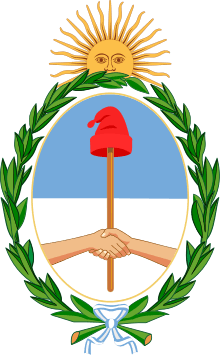Argentine legislative election, 1993
 |
| This article is part of a series on the politics and government of Argentina |
| Foreign relations |
The Argentine legislative elections of 1993 were held on 3 October. Voters chose their legislators and, with a turnout of 80.3%, it produced the following results:
Argentine Congress
| Party/Electoral Alliance | Lower House Seats |
Vote Percentage |
|---|---|---|
| Justicialist Party | 127 | 42.5% |
| Radical Civic Union | 84 | 30.2% |
| MODIN | 6 | 5.8% |
| Socialist Unity Alliance | 5 | 1.6% |
| UCeDé | 4 | 2.6% |
| Broad Front | 3 | 3.5% |
| Democratic Progressive Party | 2 | 1.3% |
| Autonomist-Liberal Pact (Corrientes Province) |
4 | 1.1% |
| Salta Renewal Party | 3 | 0.7% |
| Popular Movement (Tierra del Fuego Province) |
3 | 0.1% |
| Republican Force (Tucumán Province) |
3 | 1.4% |
| Other regional parties | 8 | 3.5% |
| Others | 5 | 5.7% |
| Invalid votes | 5.2% | |
| Total seats | 257 |
Background
Success during the 1991 mid-term elections had encouraged President Carlos Menem to approve accelerated plans for privatizations, business deregulation, and more flexible labor laws proposed by the man widely credited for his political "summer," Economy Minister Domingo Cavallo. 1992 was a banner year for the Argentine economy, which grew 9% amid a 40% jump in fixed investment and doubling of auto sales; indeed, it had been the first year since 1984 in which spending on construction and machinery exceeded depreciation (many Argentines bought their first automobile since at least then, as well).[3][4]
Storm clouds were never far from Menem's political summer skies, however. An exposé on growing corruption published by muckraking journalist Horacio Verbitsky led to the resignation of Menem's chief strategist, Interior Minister José Luis Manzano, and to that of a key ally, Buenos Aires Mayor Carlos Grosso. Continuing economic uncertainty in the United States, Europe and Japan helped lead to an unexpected crisis of confidence in Argentina, as well and, though the nation's healthy foreign exchange reserves easily thwarted a November 1992 run on the Argentine peso, the event helped trigger a sudden slowdown in Cavallo's "Argentine miracle."[5] This negative economic turn was made all the more inopportune by the coinciding wave of layoffs on the heels of mass privatizations of large employers, such as the state oil concern YPF and the nation's vast railways. Unemployment, which had remained at around 7% during the 1991-92 boom, leapt to nearly 10% by mid-1993.[6]
Corncern over layoffs, the future of the newly privatized companies and over reforms to the relatively generous adjustable pensions system inherited from populist lader Juan Perón's heyday dominated voters' issues ahead of the October 3, 1993, mid-term elections. Ultimately, fears of a recession during 1993 did not materialize and Menem quickly translated still-rising federal revenues (as well as US$3.5 billion in income from the sale of YPF stock) to increased spending on pensions and public works, helping calm protest. Sensing an opportunity to reform Argentina's arcane electoral system, the new Interior Minister, Gustavo Béliz, proposed a replacement of the nation's system of electoral lists for one resembling an Australian ballot. The proposed reform, which would lessen party leaders' influence over the process, helped result in his dismissal, however. President Menem's Justicialist Party enjoyed fourth-straight electoral victory, picking up several seats in Congress, though the struggling Radical Civic Union (UCR, which had held power during Raúl Alfonsín's difficult 1983-89 tenure), averted a trouncing and retained its Congressional strength. The UCR even made inroads in traditionally Peronist Santiago del Estero Province, where discontent with a political machinery long dominated by Justicialist Party strongman Carlos Juárez had led to riots.[7]
The results helped persuade both President Menem and UCR leader Alfonsín to negotiate towards a mutually beneficial arrangement, a month after the election. The victory encouraged Menem to pursue his goal of amending the 1853 Argentine Constitution to allow himself re-election. Alfonsín, whose party held the balance of power, accommodated the President, in exchange for increased representation in the Senate for the furst runner-up (presumably the UCR) and the relinquishing of the Presidential right - enjoyed since 1880 - to appoint the Mayor of Buenos Aires (whose voters leaned towards the UCR). The consequent Olivos Pact made the 1994 reform of the Argentine Constitution along the agreed-upon lines a reality, making this the salient legacy of the 1993 legislative elections.[7][8]
References
- ↑ Nohlen, Dieter. Elections in the Americas. Oxford University Press, 2005.
- ↑ Andy Tow's Electoral Atlas of Argentina
- ↑ Argentina: From Insolvency to Growth. The World Bank Press, 1993.
- ↑ Panorama. November 1993.
- ↑ Todo Argentina: 1992 (Spanish)
- ↑ INDEC
- 1 2 Todo Argentina:1993 (Spanish)
- ↑ Todo Argentina: Carlos Menem's first term (Spanish)